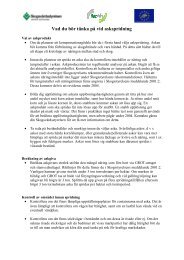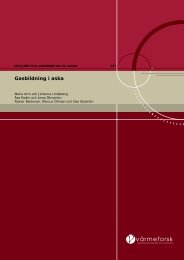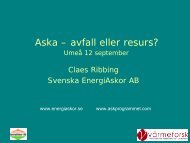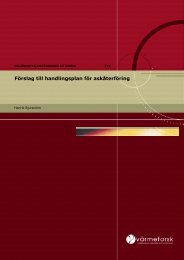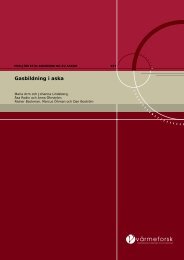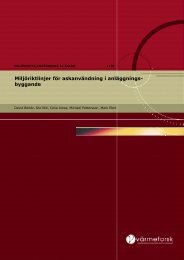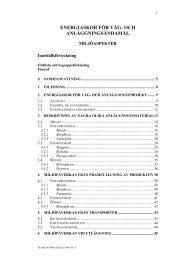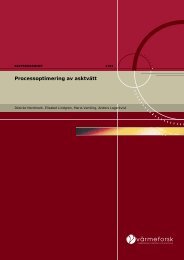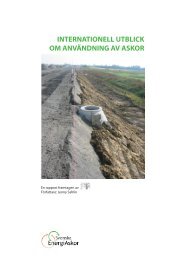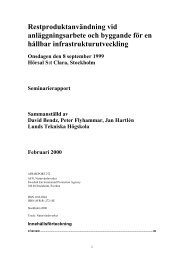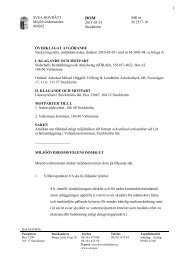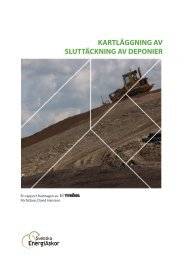rapport 1129 Potentialbedömning av flygaskor ...
rapport 1129 Potentialbedömning av flygaskor ...
rapport 1129 Potentialbedömning av flygaskor ...
Create successful ePaper yourself
Turn your PDF publications into a flip-book with our unique Google optimized e-Paper software.
Executive Summary<br />
VÄRMEFORSK<br />
Background<br />
Dredging for the development of ports and the maintenance dredging of waterways and<br />
ports means that large volumes of contaminated sediment need to be taken care of. The<br />
most troublesome are the sediments that are fine-grained and contaminated with metals,<br />
organic or organometallic (e.g. organotin) contaminants. Over the next few years, about<br />
200 000–800 000 m 3 of contaminated sediments h<strong>av</strong>e to be handled annually due to<br />
maintenance dredging and port expansions. Gävle Port alone shall dredge up to 1<br />
million m 3 of metal contaminated sediments during the years 2012–2014. These<br />
dredged materials are characterized by a muddy texture, high water ratio and low<br />
strength. The possibility of dumping at sea is limited since the dredged materials are<br />
contaminated. Moving the dredged materials to disposal sites on shore requires<br />
transportation and land area resulting in high costs. There is a great need to expand<br />
ports which means that large volumes of crushed rock and other earth materials are<br />
required to be transported to the port for the use in conventional construction of new<br />
port areas.<br />
The project STABCON (www.stabcon.com) has shown that a binder consisting of<br />
cement (construction cement) and Merit 5000 (steel slag), after stabilisation and solidification<br />
(s / s), can modify dredged materials so that predetermined geotechnical and<br />
environmental characteristics can be achieved. These masses can be used as filling<br />
materials in port structures and even replace crushed rock as filling material. Binder<br />
recipes are site specific and depend on, for example, sediment type/ dredged materials,<br />
contaminant type, contaminant content, etc. Stabilisation and solidification (s / s) means<br />
that binder is added to soft sediment / dredged materials in order to modify the strength,<br />
permeability and leaching characteristics. Stabilisation means that contaminants are<br />
chemically transformed into less mobile forms whilst solidification is a process which<br />
transforms the masses into a solid form leading to an increased strength, improved deformation<br />
characteristics and reduced permeability of dredged materials. The use of s / s<br />
treated contaminated dredged material in geotechnical constructions h<strong>av</strong>e been described<br />
in STABCON by Holm et al. (2009).<br />
Aims & Objectives<br />
The aim of this project was, from technical, environmental and economic aspects, to<br />
investigate the potential for a fly ash, or a combination of fly ashes, to be used as the<br />
components of a binder in the stabilisation and solidification of contaminated dredged<br />
material.<br />
The target audience has principally been port owners and other commercial proprietors<br />
whom are facing projects where contaminated sediments are to be disposed of. Binder<br />
producers, specifically fly ash producers, are also naturally targeted.<br />
Potential Assessment<br />
This Potential assessment has been carried out on five different fly ashes in a binder<br />
mix together with construction cement and Merit 5000 for s /s contaminated sediments<br />
from the Port of Gävle. The fly ashes’ potential was evaluated both by an inventory<br />
based on literature studies and interviews with fly ash producers and by laboratory<br />
vii



